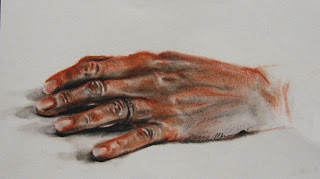Thursday, April 25, 2013
4/25/13 Basic Drawing
Today's Class- Today we continued using the conte crayons that we started with last week, but today used them together in the same drawing, to simulate a style of drawing that goes back to the Renaissance, chiaroscuro drawing. Traditional chiaroscuro drawing makes use of a piece of paper pre-colored with a medium value tone (colorful or neutral), which functions as the middle value tone in the drawing. The artist uses white crayons to draw highlights and black to draw shadows. I showed examples of this, slides and an actual drawing. Since we don't have colored paper, we simulated the concept using white paper for our lights, the red crayon for the middle tone, and the black crayon for the shadows, also shown to the class in both slide and drawing form. Above is a drawing from a previous semester.
How to make this up- Today I brought out a few mannequins, so we could try drawing something a little more complex than the usual objects. This medium particularly lends itself to head and figure. The class did two drawings, each one from one of the mannequins. Examples of student drawings and the full directions can be found here.
These are portfolio exercises and must be made up by the last day of the semester to receive full credit.
Homework- Find a shoe and light with directional light to create light and shadow patterns. Draw the shoe on a page in your sketchbook using both the red and black crayons together, paying attention to shape, proportion, and value. Then change the position of the shoe or switch to a different shoe, and do a second drawing, Total of two drawings.
For next class 5/2/13- We will be doing the final still life drawing of the semester. The class will have the full 3.5 hour class period to work on it. Students may choose from charcoal (vine or compressed), ink wash, or conte crayon (red, black, or both) to complete their drawing. Bring your 18" x 24 pad, the medium of your choice, and any related materials (spray fixative, blending tools, etc).
Subscribe to:
Post Comments (Atom)

No comments:
Post a Comment
Note: Only a member of this blog may post a comment.